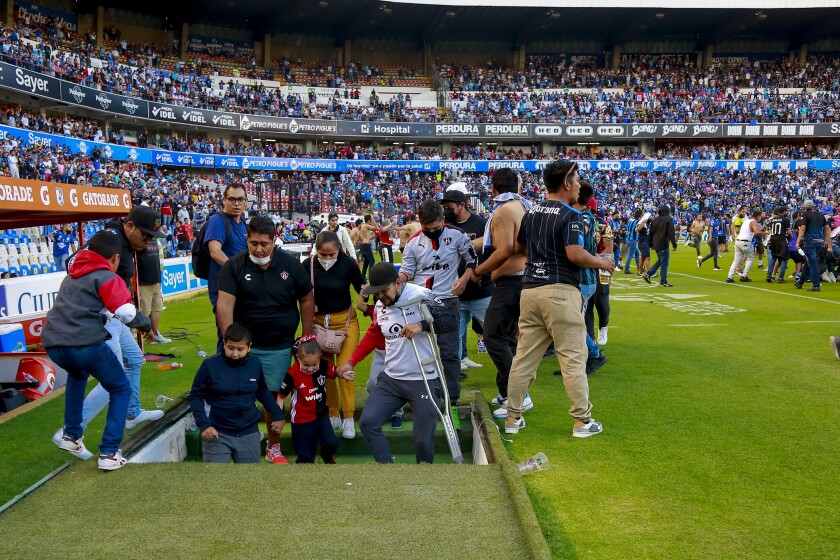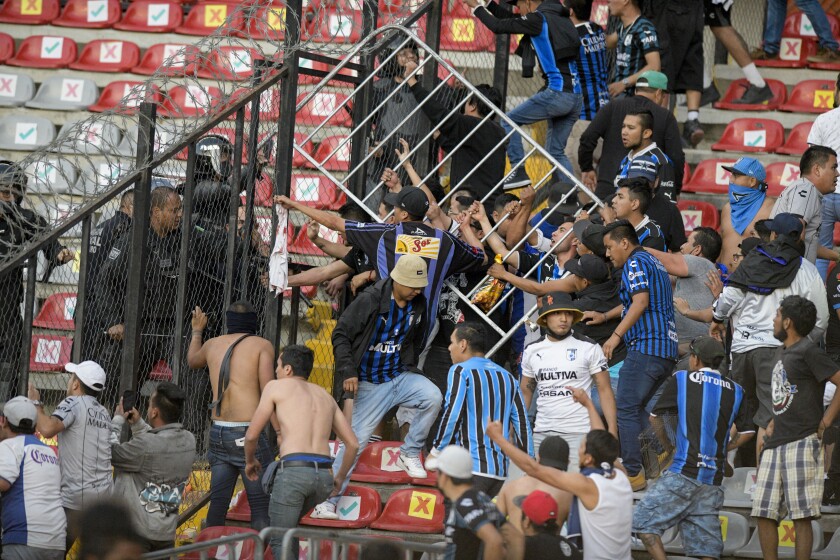The images coming out of the main soccer stadium in the central Mexican city of Querétaro are as indelible as they are indefensible.
On Saturday, early in the second half of a Mexican league game between visiting Atlas, the reigning champion, and Querétaro FC, a team that has never finished better than sixth in the standings, a riot broke out in Estadio Corregidora, named for a hero in Mexico’s war of independence.
Fans attacked one another with chairs, metal bars, knives, belts, fists and feet, with official reports saying as many as 26 people were hospitalized, three in critical condition. A competing report said the number was nearly twice that high.
On Sunday, the local government said there were no fatalities, but images of bloody and unconscious bodies — including one of a man lying naked in a pool of his own blood — as well as interviews with some victims and family members indicated fans were killed.
Reports cited by independent observers, including TV Azteca journalist David Medrano, said 17 people had died. Others reported the toll was higher.
Fans fight during a Liga MX soccer match between host Querétaro and Atlas at Corregidora Stadium on Saturday.
(Sergio Gonzalez / Associated Press)
On Sunday, Medrano tweeted out a photo and confirmation of one of the dead fans, to an Atlas fan. At least two other videos surfaced Sunday of Atlas fans who insisted they had friends who died in the stadium attacks.
In response, Liga MX, Mexico’s domestic soccer league, pointed back to the state’s statement that no one had died. Many questioned it.
“Mexico’s had a history of distrust with government officials over death tolls, whether that’s students gone missing, whether that’s femicide, whether that’s COVID debts,” said Hérculez Gómez, a former US national team player who spent six seasons in the Mexican league. “There’s a history of government misinformation and disturb among its people. And that’s going on right now.
“That’s the worst part. That’s the scary part.”
Atlas supporter groups took to social media to post lists of those known to be hospitalized and notices seeking information on the safety and whereabouts of others who disappeared in the violence. At the team’s stadium in Guadalajara, a candlelight vigil was held.
One image stood out from the rest.
A man kneels on the grass, defenseless, using his body to shield a boy he holds in his left arm while trying to protect his own head with his right arm. Several men rush in from the right to kick and beat the pair.
The man and the boy are wearing the jerseys of their favorite soccer team. The attackers are wearing the jerseys of their rivals.
“The one place you should feel safe, the one place you should feel secure, that one place that should be a family environment, wasn’t,” said Gómez, a soccer analyst for ESPN.

Fans go down stairs on the field Saturday at Corregidora Stadium in Querétaro, Mexico, to avoid a riot in the stands.
(Eduardo Gomez-Reyna/Associated Press)
Blame for the violence fell mostly with hard-core Querétaro fans, known as barras bravas, or fierce gangs, in Spanish. Most, if not all, of the people who were hospitalized were Atlas supporters.
Blame also was leveled at the stadium’s lax security detail, which was largely made up of privately contracted officers who were slow to react and ineffective at controlling the violence.
Querétaro club president Gabriel Solares said during a news conference that there were 600 security personnel in a stadium that seats nearly 34,000 people. Why a more robust security presence wasn’t on site for a match between teams with a recent history of fan violence certainly will be addressed in the multiple investigations being promised.
Also to be addressed is why barriers meant to separate the rival supporter groups were easily breached after fighting began in the stands, allowing the violence to spill onto the field.
The Mexico City newspaper El Universal called it “the darkest day for Mexican soccer.”

Fans clash during a Liga MX soccer match between Querétaro and Atlas at Corregidora Stadium in Querétaro, Mexico.
(Sergio Gonzalez / Associated Press)
While coping with the violence, fans on social media defended their country in response to those who attributed the brawl to a violent Mexican culture.
“We understand that that’s a problem, but it’s not just a brown people problem,” said Sergio Tristan, an attorney in Austin, Texas, and the founder of Pancho Villa’s Army, the largest organized group of Mexican soccer fans in the US “These are problems across the world.”
More than 50 countries on six continents have seen some level of soccer hooliganism. Ten years ago, a riot in an Egyptian stadium left 74 people dead and more than 500 others injured. The government shut down the country’s domestic soccer league for two years in response.
In many Baltic countries, supporter groups have long been havens for fascist and paramilitary groups who use team affiliation as a cover for attacking political rivals. The same holds in Italy.
In France and England, hooliganism often has been triggered by social tensions, with violence once so commonplace in the United Kingdom that it was referred to as the English Disease, and women and children were dissuaded from attending games.
Nationalism, meanwhile, fed a wave of bloody violence during the 2016 European Championships in France.
And in Los Angeles, Bryan Stow, a Giants baseball fan, nearly died after being beaten in the parking lot at Dodger Stadium. A Mets fan was beaten in the same parking lot and nearly died four years later.
While Mexican fans on both sides of the border defended their country’s values and soccer on social media, they also leveled criticism at official reaction to the violence.
The first reaction of Liga MX President Mikel Arriola, on Twitter, was to describe the scene in Querétaro as “unacceptable and regrettable.” The rest of the league schedule continued Saturday night before he canceled four matches scheduled for Sunday and Tuesday.
On Sunday, Arriola called the violence “unfortunate” while promising an investigation and possible sanctions.
Tristan sees the riot as a wake-up call for Liga MX.
“The Mexican league has to ask itself how they want to come out of this this tragedy,” he said. “It’s going to have to be harsh punishment. Whether that’s banning barras or implementing a more stringent security process in each stadium, they have to look at this with an end state of coming out stronger and better as a league that looks after its fans. They have to implement some rigid, strict policies and punishments.”
CONCACAF, the federation that oversees soccer for 41 member states in North America, Central America and the Caribbean, called the violence “shocking” and said it condemns the behavior. It also called for an investigation and sanctions.
FIFA, the governing body for global soccer, described the riot as “barbaric” and encouraged local authorities to bring “swift justice to those responsible.”
Mauricio Kuri, Querétaro’s governor, announced he will seek attempted murder charges for those involved in the riot.
💔😞UNA IMAGEN DE VERGÜENZA MUNDIAL
Una de las familias que huyó de las gradas en La Corregidora por la violencia en las gradas…
A la izquierda, un pequeño se desprendió de su playera para sortear los actos en el Querétaro vs Atlas…#GallosxFOX pic.twitter.com/k6AJOnqlPL
— FOX Sports MX (@FOXSportsMX) March 6, 2022
Tristan won’t soon forget another image that circulated online during the weekend. It shows a family of four running across the Querétaro field, the second-youngest member shirtless after his father removed his jersey to avoid being identified as an Atlas fan. Everyone in the photo had come out on a warm Saturday afternoon to see a soccer match, only to wind up in a riot.
“That kind of just broke my heart,” Tristan said. “If a little kid can’t go to a stadium with his favorite jersey on to support his team, what are we even doing here as a league, as a country, as a fan base?”


Comments are closed.